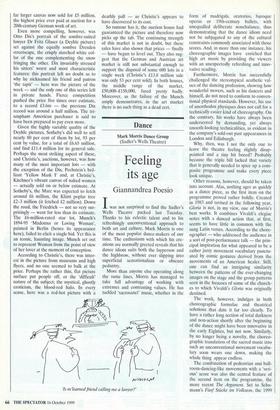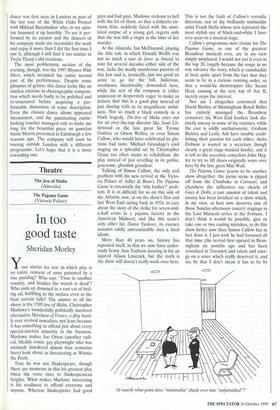Dance
Mark Morris Dance Group (Sadler's Wells Theatre)
Feeling its age
Giannandrea Poesio
Iwas not surprised to find the Sadler's Wells Theatre packed last Tuesday. Thanks to his eclectic talent and to his refreshingly unconventional approach to both art and culture, Mark Morris is one of the most popular dance-makers of our time. The enthusiasm with which his cre- ations are normally greeted reveals that his dance idiom suits both the layperson and the highbrow, without ever slipping into superficial sensationalism or obscure pedantry.
More than anyone else operating along the same limes, Morris has managed to take full advantage of working with extremes and contrasting values. He has tackled 'sacrosanct' music, whether in the 15 mleamed friend calling me a lawyer?' form of madrigals, oratorios, baroque operas or 19th-century ballets, with unequalled deliberate nonchalance, thus demonstrating that the dance idiom need not be subjugated to any of the cultural constraints commonly associated with those scores. And, in more than one instance, his choreographic images have enriched that high art music by providing the viewers with an unexpectedly refreshing and inno- vative reading.
Furthermore, Morris has successfully challenged the stereotypical aesthetic val- ues of the dancing profession, showing how wonderful movers, such as his dancers and himself, do not need to conform to conven- tional physical standards. However, his use of unorthodox physiques does not call for a technically easier kind of choreography. On the contrary, his works have always been underscored by demanding, yet always smooth-looking technicalities, as evident in the company's sold-out past appearances in London and Edinburgh.
Why, then, was I not the only one to leave the theatre feeling slightly disap- pointed and a tiny bit bored? Probably because the triple bill lacked that variety that is generally needed to spice up a com- posite programme and make every piece look unique.
Other reasons, however, should be taken into account. Alas, nothing ages as quickly as a dance piece, as the first item on the programme proved rather boldly. Created in 1983 and revised in the following year, Gloria is not, in my view, one of Morris's best works. It combines Vivaldi's elegiac notes with a danced action that, at first, seems to have little in common with the sung Latin verses. According to the chore- ographer — who addressed the audience in a sort of post-performance talk — the prin- cipal inspiration for what appeared to be a rather jazzy movement vocabulary punctu- ated by comic gestures derived from the movements of an American healer. Still, one can find an intriguing similarity between the patterns of the ever-changing images on the stage and the group patterns seen in the frescoes of some of the church- es to which Vivaldi's Gloria was originally destined.
The work, however, indulges in both choreographic formulae and theatrical solutions that date it far too clearly. To have a rather long section of total darkness and non-action shortly after the beginning of the dance might have been innovative in the early Eighties, but not now. Similarly, by no longer being a novelty, the choreo- graphic translation of the sacred music into such an unconventional movement vocabu- lary soon wears one down, making the whole thing appear endless.
The combination of pedestrian and ball- room-dancing-like movements with a 'seri-
ous' score was also the central feature of the second item on the programme, the more recent The Argument. Set to Schu- mann's Film' Stiicke im Volkston, the 1999
dance was first seen in London as part of the last tour of the White Oaks Project with Mikhail Baryshnikov who, in my opin- ion hammed it up horribly. To see it per- formed by its creator and the dancers of his company made me reconsider the work and enjoy it more than I did the first time I saw it, although I still find it too similar to Twyla Tharp's old creations.
The most problematic section of the evening, though, was the 1997 Rhymes With Silver, which occupied the entire second part of the performance. Despite some glimpses of genius, this dance looks like an aimless exercise in choreographic composi- tion which needs badly to be polished and re-structured before acquiring a per- formable dimension of some description. Even the chosen dance idiom appeared inconsistent, and the punctuating exotic- looking touches managed only to make me long for the beautiful piece on gamelan music Morris presented in Edinburgh a few seasons ago. The company will soon be touring outside London with a different programme. Let's hope that it is a more rewarding one.



















































































 Previous page
Previous page